|
|
|
Sort Order |
|
|
|
Items / Page
|
|
|
|
|
|
|
| Srl | Item |
| 1 |
ID:
171645
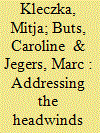

|
|
|
|
|
| Summary/Abstract |
The European arms industry is challenged by several adverse “headwinds.” Fragmentation leads to costly duplications and, in conjunction with stagnating budgets and sharply increasing costs, prevents firms from exploiting economies of scale and learning. This is exacerbated by size differentials vis-a-vis the leading US arms manufacturers and competition from emerging producers. As some “headwinds” are self-enforcing, far-reaching industrial and policy responses are required to improve the industry's outlook. As exports may not indefinitely compensate for low domestic demand, there is an economic imperative for further cross-border collaboration and consolidation. Despite various EU policy initiatives, progresses regarding the European Defence Equipment Market and strengthening the European Defence Technological Industrial Base have been relatively slow. It remains to be seen whether the European Defence Fund will be the proclaimed “game-changer,” raising competitiveness of the European arms industry. At the same time, the UK's withdrawal from the EU adds uncertainties.
|
|
|
|
|
|
|
|
|
|
|
|
|
|
|
|
| 2 |
ID:
192039
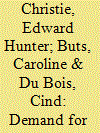

|
|
|
|
|
| Summary/Abstract |
We explore the possibilities and limitations of models of the demand for military expenditures, as against additional kinds of cross-country analyses, with an empirical focus on the Indo-Pacific region. Our research bridges a gap between the Defence Economics and International Relations literatures by developing testable security alignment hypotheses and by testing these hypotheses in three ways: with demand modelling on total expenditures, with analyses on estimated stocks of imported armaments, and with qualitative analyses of trends in defence cooperation between states. We find consistent evidence across research methods of an increase in threat perceptions towards China since around 2012 and of balancing behaviour by US allies and by two non-allies. As compared to standard demand modelling, our hypothesis-based mixed methods approach allows for a clearer treatment of samples with mixed and shifting security alignments and of states that stabilise or reduce expenditures in the face of rising threat perceptions.
|
|
|
|
|
|
|
|
|
|
|
|
|
|
|
|
| 3 |
ID:
188410
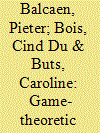

|
|
|
|
|
| Summary/Abstract |
For decades, the concept of deterrence and the fear for nuclear confrontation withheld large powers from waging aggression against each other. Recent technological developments and the growing interconnectedness however allowed some states to find ways to challenge the West by using so called ‘hybrid threats’. This way of waging war entails the synchronized use of a broad spectrum of instruments that are well-designed to stay below the thresholds of detection, attribution and retaliation. Combining these (relatively cheap) threats with conventional military hard power confronts the liberal democracies with a difficult choice in terms of defence budget allocation. Whereas arms race stability in the conventional and nuclear domain leads to a peaceful stalemate, this article demonstrates that adding hybrid threats to the spectrum of state power projection leads to a gradual shift of the power balance. While hybrid threats have been extensively studied within the international relations literature, we are (to the best of our knowledge) the first to study these changing security paradigms from a defence economic point of view. Moreover, this article is the first to represent this increasingly complicated state power competition in a game theoretic framework.
|
|
|
|
|
|
|
|
|
|
|
|
|
|
|
|
| 4 |
ID:
155836
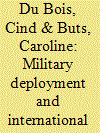

|
|
|
|
|
| Summary/Abstract |
Extant literature documents a relationship between military deployment and the risk of an international terrorist attack against citizens of the deploying country. It appears that deployment significantly increases the possibility of terrorist actions in the home country. In particular, if country A decides to send troops to nation B, then citizens of the former country are more likely to fall victim of an attack carried out by a terrorist organisation originating from the latter country. Contributing to this line of literature, we further refine this relationship by distinguishing between regions where the troops are sent as well as by introducing differences between types of deployment. Our results indicate that missions to Asia and the Middle East are more dangerous than missions to other regions as reflected by the terrorist threat in the home country. Robustness tests do however show that the significance of the location variable Asia is predominantly attributed to the mission to Afghanistan. As for types of deployment, only ad hoc missions seem to increase the risk of an attack, whereas no significant results are found for other missions such as operations under UN and NATO flag. Leaving out the missions to Iraq and Afghanistan however also increases the danger resulting from missions by fixed coalitions. Our results find however no evidence that ‘wearing a blue helmet’ increases the probability of a terrorist attack at home.
|
|
|
|
|
|
|
|
|
|
|
|
|
|
|
|
| 5 |
ID:
146504
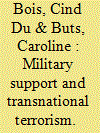

|
|
|
|
|
| Summary/Abstract |
Analysing the relationship between the provision of military support and the probability of becoming the target of a terrorist attack, this paper contributes to the literature on the causes of transnational terrorism. We find that deployment of military troops of country X in country Y increases the probability of a terrorist attack on citizens of country X by a terrorist group located in country Y. Exporting weapons to country Y seems to increase the probability of being attacked by the terrorists of this country Y as well. Deploying materials, however, does not seem to significantly influence the probability of attack. Including lagged values for our military support variables ensures that the causality direction is from military support to terrorist attacks. Moreover, these results indicate that while the effect of military deployment on the probability of attack lasts for more than 1 year, the effect is rather short-lived.
|
|
|
|
|
|
|
|
|
|
|
|
|
|
|
|
| 6 |
ID:
189456
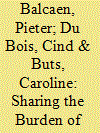

|
|
|
|
|
| Summary/Abstract |
This article discusses the effects of the changing (hybrid) conflict environment on the burden sharing debate. We discuss the actions taken by both the alliance as the member states in repelling these threats, arguing that this mainly produces security outputs that are private or impure public. As the burden sharing literature currently lacks notions of hybrid threats, we believe the current modelling to be ill-suited to provide reliable assessments of member states’ burden sharing behaviour. We address this void by adjusting the Joint Product Model, extending a country’s security activities to a more inclusive ‘whole of government (WoG) approach’. We depart from this WoG model to stress the challenges associated with comparing the contributions of member states in countering these threats. This leads us to dispute the use of aggregate military expenditures as a main variable to measure a country’s degree of free riding. More and other types of (non-military) variables and proxy-indexes should be taken into account. The same remark goes for estimating the benefit-burden concordance within this framework of permanent non-linear state competition.
|
|
|
|
|
|
|
|
|
|
|
|
|
|
|
|
| 7 |
ID:
182547
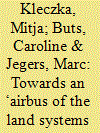

|
|
|
|
|
| Summary/Abstract |
Despite considerable restructuring since the end of the Cold War, the European armoured vehicle industry remains largely fragmented along national lines. As stagnating domestic budgets, rising R&D and production costs and the limits of export-focused industrial strategies provide an economic imperative for further consolidation, the merger of Nexter and Krauss-Maffei Wegmann in 2015 has often been regarded as a mere starting point for a wider trans-European reorganisation process which could even result in a land-based equivalent to Airbus. This article proposes a new classification system to identify the ‘prime competitors’ of the European armoured vehicle industry and debates prospects for further consolidation among them. By means of a volume-based variant of the HHI, concentration in European procurement of armoured vehicles is estimated and various merger simulations are conducted. The results suggest that, while the European armoured vehicle industry will likely experience further consolidation, this process will probably be too small in scope to create an ‘Airbus of the land systems sector’. In the medium to long term, however, market pressures and collaborative programmes such as the Main Ground Combat System might have the potential to create a ‘European champion’ in selected subsectors of the armoured vehicle industry.
|
|
|
|
|
|
|
|
|
|
|
|
|
|
|
|
|
|
|
|
|